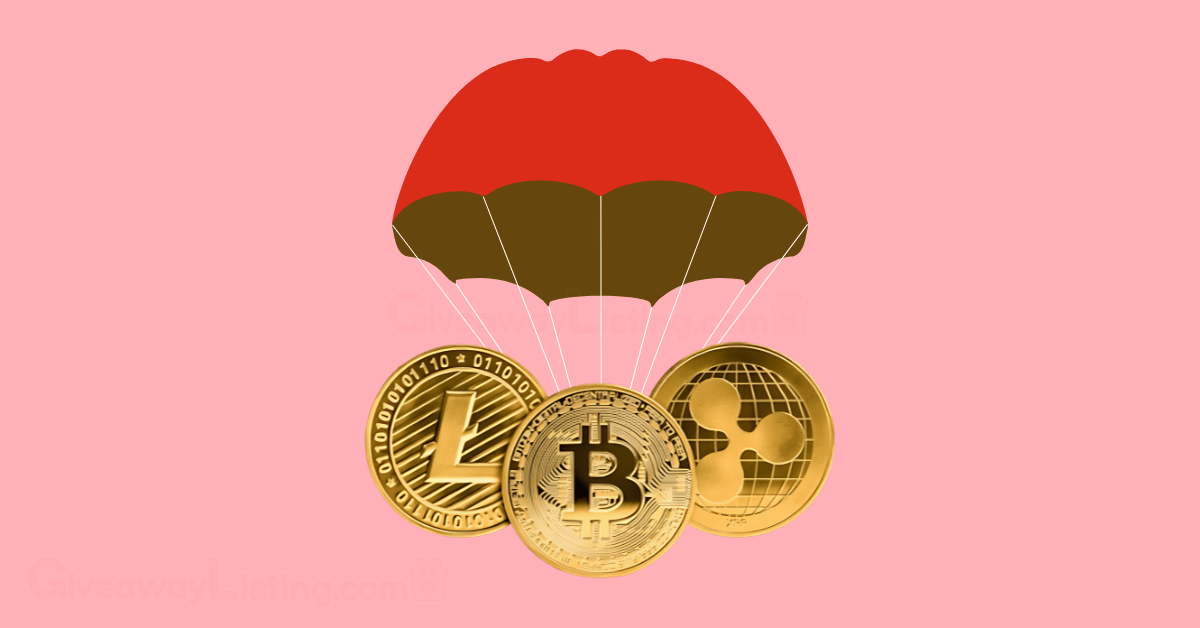Basics of Airdrops
Crypto airdrops are a way for new and sometimes established blockchain projects to distribute their tokens to a wide audience. It is similar to a promotional giveaway, where a project distributes its digital currency to people. These airdrop distributions aim to build a community, raise awareness about their project, or reward early supporters.
This article, current as of December 2025, will walk you through several important aspects of this topic. We’ll explore what airdrop farming entails, including how to obtain crypto airdrops using the 7 best practices, as well as some top free crypto airdrops of 2025, and how to claim free airdrops on Trust Wallet.
What is Airdrop Farming?

A crypto airdrop is basically a distribution method where a project sends out its native cryptocurrency tokens to the wallet addresses of numerous users. These are often given away for free or in return for performing simple promotional activities.
The primary aim of projects doing this is usually marketing, to increase awareness about their coin or platform and grow their user base. It’s a technique to get their tokens into more hands and, hopefully, create a more active and widespread community.
The first-ever crypto airdrop took place in 2014, when Auroracoin distributed AUR tokens to the population of Iceland, with each eligible resident receiving 31.8 AUR. This event set a precedent for future projects.
Sometimes, all you need is a crypto wallet that holds a specific existing cryptocurrency by a certain date. This date is often referred to as a “snapshot”. At other times, projects may ask you to follow their social media, join a community group, or share a post.
The tokens are then automatically sent to the wallets that meet the set conditions. For instance, the Uniswap airdrop in 2020 gave 400 UNI tokens to each wallet that had previously used the exchange, a move worth around $1,400 per recipient at the time.
Now, airdrop farming is the practice of actively participating in multiple airdrop campaigns to collect as many free tokens as possible from various blockchain projects. People who engage in this practice, known as airdrop farmers or hunters, aim to accumulate tokens that they may hold for future appreciation, sell for immediate profit, or utilize within the token’s ecosystem, such as for staking.
Airdrop farming can involve more than just signing up for every announced airdrop. Farmers might interact with new platforms before they even launch a token, hoping to be rewarded retroactively as early users. This could involve using test versions of networks, known as testnets.
Some airdrop farmers manage multiple wallets to increase their chances of receiving a higher amount of tokens from a single airdrop campaign. However, projects are getting better at identifying such patterns.
The effort can range from minimal to quite substantial, demanding research, time, and sometimes a modest amount of initial capital to cover transaction fees or to hold specific prerequisite tokens. The idea is that the cumulative value of farmed tokens, especially if some of the projects become successful, can be significant.
How to Get Crypto Airdrops? 7 Best Practices

Obtaining crypto airdrops requires some knowledge and proactive effort. You have to know where to look and also stay safe. Claiming airdrops requires meeting specific criteria set by the project, which can range from holding specific tokens to actively participating in their communities or testing their platforms.
Here are seven top-tier practices to help you get those airdrops in 2025:
1. Stay Informed and Do Your Homework
The crypto space is filled with new projects, and many announce airdrops through official channels. Make it a habit to follow projects on their social media, join their Discord communities, and regularly check their official websites and blogs. This is where you’ll find the most accurate details about upcoming airdrops, including eligibility rules and timelines.
Beyond just finding them, research is key. Before you jump into any airdrop, look into the project itself. Who is the team behind it? Do they have a clear roadmap and a genuine product or service? Check for community feedback and reviews.
A startling number of airdrop announcements can be scams designed to get your personal information or, worse, access to your wallet. Legitimate projects will never ask for your private keys or request that you send cryptocurrency to receive an airdrop.
2. Secure Your Wallet
Your crypto wallet is your gateway to airdrops, but it’s also a target. Always use a reputable and secure wallet. For airdrop hunting, many expert crypto traders recommend using a separate wallet, rather than your main wallet, where you store the bulk of your assets. The essence of this is to protect your holdings if you accidentally interact with a malicious site or contract.
Never, ever share your private keys or seed phrase with anyone or any website. Your private keys are the access to your funds, and no legitimate airdrop will ever need them. Be extremely cautious about the permissions you grant to decentralized applications (dApps) and regularly review and revoke connections that you no longer need or trust.
3. Get Involved with Projects and Communities
Many airdrops, especially retroactive ones, reward users for their early and active participation. This can involve using a platform’s services which can include trading on a decentralized exchange, bridging tokens, or providing liquidity.
Some projects airdrop tokens to users who participate in their testnets, helping them fish out bugs before the main launch. This often requires time and effort, but can lead to substantial rewards.
Engaging with the project’s community by participating in discussions, offering feedback, and helping new users can sometimes make you eligible for exclusive airdrops or increase your allocation.
4. Understand the Eligibility Rules
Each airdrop has its own set of rules. Pay close attention to these. A common requirement is that users hold a certain amount of a specific cryptocurrency in their wallets by a snapshot date and time. If your wallet doesn’t meet the criteria at that exact moment, you’ll likely miss out.
Other requirements might involve specific tasks like following social media accounts, joining a Telegram group, referring friends, or even completing quizzes. Make sure you complete all required steps accurately. Some projects have multi-tiered rewards, meaning the more conditions you meet or the more actively you participated, the larger your airdrop might be.
5. Keep Tabs on Your Airdrop Activities
When you’re actively hunting for airdrops, it’s easy to lose track of which ones you’ve signed up for, what tasks you’ve completed, and when the tokens are expected to be distributed. Consider using a spreadsheet or an airdrop tracking tool to stay organized.
Note down the project name, the required tasks, the snapshot date (if applicable), the expected distribution date, and the official links. This not only helps you manage your efforts but also makes it easier to follow up if you don’t receive tokens you were expecting. You can always contact the project’s support team if you have any concerns or complaints.
6. Be Patient and Keep Expectations Realistic
Not every airdrop will make you rich overnight. Many airdropped tokens might have little to no value initially, and some may never gain significant traction. The crypto market is volatile, and the value of airdropped tokens can fluctuate wildly. Sometimes, it takes a while for a project to grow and for its token to appreciate.
Also, token distribution can sometimes be delayed. Be patient and follow project updates. Don’t get disheartened if some airdrops don’t pan out; it’s part of the game. The goal is to accumulate a variety of tokens, hoping a few will turn into winners.
7. Be Aware of Tax Responsibilities
Depending on where you live, receiving crypto airdrops could have tax implications. Many tax authorities treat airdropped tokens as income at their fair market value at the time you receive them. If you later sell these tokens, you might also be subject to capital gains tax.
It’s a good idea to keep records of the airdrops you receive, including the date, the number of tokens, and their approximate value at the time of receipt. Tax rules for crypto can be complex and vary by jurisdiction, so it’s best to consult with a tax professional who is familiar with cryptocurrency if you’re dealing with significant amounts.
Top Free Crypto Airdrops of 2025

For those looking to find some of the best airdrops, 2025 has several promising projects on the horizon that might distribute tokens to their communities. Some of them include the following:
- LayerZero: This is an interoperability protocol aiming to connect different blockchains, and it’s widely anticipated to conduct an airdrop for its users.
- MetaMask: While primarily known as a leading crypto wallet, there’s ongoing discussion about a potential token and airdrop for its millions of users, especially those who have used its swap features.
- zkSync: A Layer 2 scaling solution for Ethereum, zkSync is another major project expected to reward its early users and community members with a token airdrop.
- StarkNet: This is a decentralized ZK-Rollup that has confirmed plans for a token.
- EigenLayer: This is an Ethereum restaking protocol that has garnered significant attention; users who have restaked ETH or Liquid Staking Tokens are hopeful for a substantial airdrop.
- Scroll: Another zkEVM Layer 2 network for Ethereum, Scroll has been in development and testing, with an airdrop being a common expectation for projects at this stage to incentivize early adoption.
- Quai Network: A Layer 1 network of merged-mined blockchains, Quai Network has been running incentivized testnets, often a precursor to an airdrop for participants.
Keep in mind that airdrop confirmations and details are subject to change, so always refer to the official project communications for the most up-to-date information.
How to Get Free Airdrop on Trust Wallet?

Trust Wallet is a well-known multi-currency crypto wallet, popular for its user-friendly design and strong security features. It allows people to store, send, and receive a broad range of digital assets. Binance acquired Trust Wallet in 2018. The wallet also features its own native token, TWT (Trust Wallet Token), which offers certain advantages within its ecosystem.
Trust Wallet has been connected with several airdrop events, particularly involving its TWT token. For example, there have been campaigns, sometimes run with Binance, where large quantities of TWT were distributed.
One such event involved giving out 10 million TWT tokens to users who met specific conditions, such as downloading the Trust Wallet app and having a Binance account. While Trust Wallet serves as a versatile wallet for receiving tokens from various projects’ airdrops due to its broad multi-chain support, it also utilizes airdrops to reward its community and promote its platform.
To position yourself for potential free airdrops that you might receive or manage through Trust Wallet, consider these steps:
- Get Trust Wallet: The first step is to download the official Trust Wallet application from your device’s app store or get the browser extension from their official website.
- Secure Setup: Create a new wallet or, if you have one, import an existing one. The most critical part of this step is to securely back up your recovery phrase. Write it down and store it somewhere safe where no one else can access it. This phrase is the only way to get your wallet back if you lose access to your device.
- Stay Active: Using your wallet for regular transactions and interacting with its features, like the DApp browser, can sometimes be a factor in airdrop eligibility for various projects.
- Consider Holding TWT: While not always a requirement, holding some Trust Wallet Tokens (TWT) in your wallet might make you eligible for specific airdrops or benefits offered directly by the Trust Wallet project.
- Follow Official Announcements: Keep a close watch on Trust Wallet’s official social media channels, their blog, and community forums. This is where they are most likely to announce any airdrops they are conducting or involved with, including any specific requirements.
What is Airdrop? The Bottom Line

We’ve covered a lot about crypto airdrops, including understanding what airdrop farming entails, identifying the 7 best practices for acquiring them, exploring top free crypto airdrops for 2025, and examining how a platform like Trust Wallet fits into the picture.
It’s clear that airdrops are more than just freebies; they play a big role in the growth and community building of the crypto ecosystem.
Here are some interesting takeaways:
- The concept of a crypto airdrop isn’t new; the first one dates back to 2014, when Auroracoin distributed 31.8 AUR to each eligible Icelandic citizen.
- The Uniswap airdrop in 2020 was a game-changer, delivering 400 UNI tokens, worth approximately $1,400 at the time, to over 250,000 early platform users.
- The combined value of just the top seven crypto airdrops has exceeded $21 billion, reaching over 3.3 million different wallet addresses.
- Data suggests a strong speculative interest shortly after distribution, with 46% of the top fifty biggest airdrops hitting their all-time high token price within two weeks of the event.
- In 2017, the Stellar Development Foundation distributed a massive 16 billion XLM tokens to Bitcoin holders.
This information is up-to-date as of December 2025.
FAQs
Here are answers to some frequently asked questions about airdrops in 2025.
How to Start a Crypto Airdrop?
Projects initiate airdrops by defining objectives, such as increasing awareness or rewarding loyalty. They then set clear rules for who gets tokens—perhaps existing token holders or those completing tasks; Uniswap targeted over 250,000 early users.
After announcing the airdrop campaign, tokens aredistributed to eligible wallets, often automatically using smart contracts, with some projects, like Jito, allocating 10% of their total supply.
How to Make Money From Airdrops?
You can earn money from airdrops by holding the received tokens, as their value may increase; 46% of the top 50 airdrops reached their peak prices within two weeks. Another option is to sell the tokens on cryptocurrency exchanges. Some airdrops have been quite valuable from the outset, such as Uniswap.

